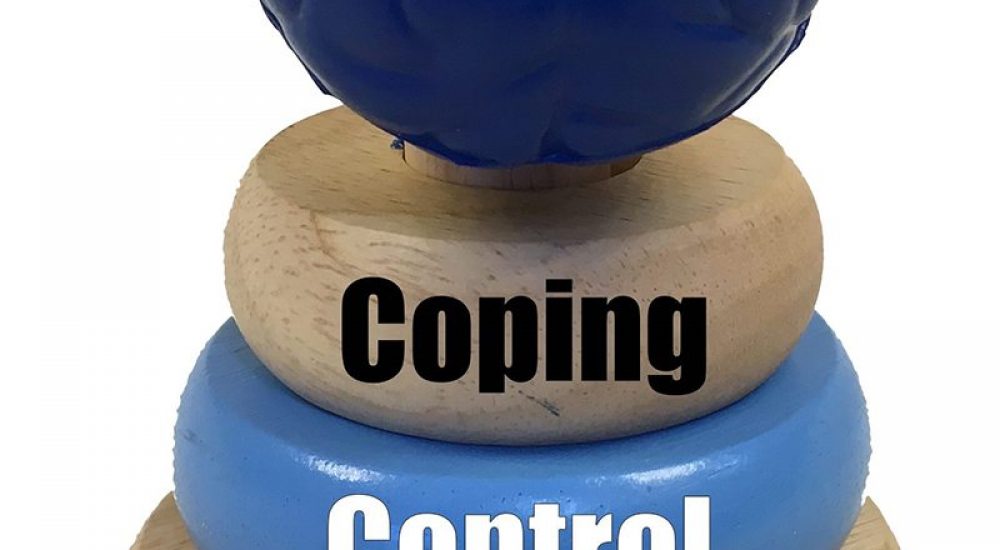You may have heard of Albert Einstein’s famous equation on his theory of relativity… E = MC2.
Our slightly less-famous equation on our theory of grittiness is…
G stands for Grit
I first learned about “grit” from John Wayne (True Grit – 1969 Western), but it took educational research rock star Angela Lee Duckworth (author of Grit: The Power of Passion and Perseverance) to make “grit” a buzzword in education, and a fundamental targeted outcome for our own afterschool programs. Duckworth studied West Point cadets, national spelling bee contestants, students in Chicago Public Schools, and corporate salespeople. All of her research subjects showed that grit is a better predictor of success than other factors like IQ. She says, “Grit is passion and perseverance for very long-term goals. Grit is having stamina. Grit is sticking with your future, day-in, day-out. Not just for the week, not just for the month, but for years. And working really hard to make that future a reality. Grit is living life like it’s a marathon, not a sprint.”
Grit is guts, resilience, insistence, tenacity, determination, endurance, hardiness, resolve, fortitude, mettle, and perseverance. At BOOST 2017, we will present our conceptual model, which represents grit as a complete ring-stacking toy. Grit = Mindset (Confidence X Control X Coping). Grit begins with a foundation of mindset upon which everything else is supported and aligned.
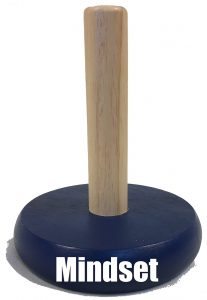 M Stands for Mindset
M Stands for Mindset
As babies, we learn to use words to express what we want. Later words evolve into something greater as they become a type of thought called “inner speech”
– a little voice in our head. For example, simple words like “smart” or “gifted” or “birthday” are big concepts that contain many complex nuances when they exist as inner speech. As we grow and interact with our environment, relationships, and experiences (the ERE), inner speech evolves into “mindset.”
Carol Dweck, world-renowned Stanford University psychologist and author of the best-selling book Mindset: The New Psychology of Success, discovered significant links between mindset and stress, success, and achievement. Mindset is the accumulation of our paradigms, mental models, beliefs, attitudes, and perceptions about ourselves and our place in the world. Our mindset can be positive or negative; growth or fixed depending on our interactions with the ERE.
Under a fixed mindset, we might view intelligence is genetic. It is something you are born with. You can learn new things, but you can’t change your basic level of intelligence. Under a fixed mindset, we might view talent in certain areas as something that you either have, or you don’t.
We are all dealt a genetic hand of cards (some of us were dealt jokers). Under a growth mindset, we understand that with effort, we can improve our hand substantially. Those who are born the smartest don’t always end up the smartest because effort is the primary driver of development and learning. Under a growth mindset, we know that with effort and deliberate practice, we can grow a better brain, and substantially improve our skills.
With a growth mindset, we emphasize effort over talent or smarts. When we hear the little voice in our heads say things with a fixed mindset voice like, “I will fail at this, and nobody will respect me.” We must talk back to ourselves with a growth mindset voice, “If I don’t try, I automatically fail. Where’s the respect in that.” Then, we choose a growth behavior – take a risk, learn, prepare, work hard, engage in deliberate practice with a stretch goal.
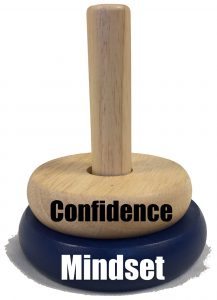 C1 Stands for Confidence
C1 Stands for Confidence
Confidence is built upon a growth mindset. Confidence is a sense of being loved and being capable. When we begin from a mindset that says, “I can get better at this if I learn and work hard,” we can lack confidence in a certain skill or academic subject and still grow our grit. Our inner voice can say, “Wow, I really… really stink at this,” and still come from a growth mindset, if we follow up with, “I need a lot of practice to get better.”
One of the most powerful things we can do to help our children and youth to build the confidence they need to grow grit is to listen, just listen. Let them finish. If they say something like, “Nobody likes me.” Don’t say, “That’s not true.” Definitely don’t say, “Well, I like you.” Wretch-vomit.
Instead say, “Tell me more.”
Mindset is influenced by the cues we get from the ERE especially right after we make mistakes. When kids make mistakes. Let them know that mistakes are expected. Mistakes are learning opportunities. Say, “That’s OK. Just hit your reset button. Improve your strategy, and try it again.”
The whole concept of growth mindset could be expressed in a single word… yet. There is power in that one little word. When you hear yourself or others say in a fixed mindset voice, “I don’t know” or “I can’t.” Talk back to them and ask them to add that single word. Don’t say “I can’t” say “I can’t… YET.” With what Carol Dweck calls the “Power of Yet” we can help kids build the confidence they need to get gritty.
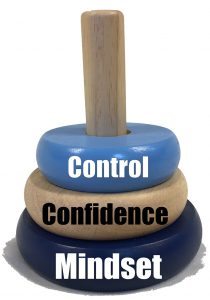 C2 Stands for Control
C2 Stands for Control
Once we have a foundation of growth mindset, and we add the skill of Confidence – a sense of personal power, we can use that Confidence to help ourselves and others develop an Inner Locus of Control.
One of the most powerful things we can do to help our children and youth build control is to teach them about neuroplasticity. Cutting-edge neuroscience teaches us that the brain is not fixed. Throughout out entire lives, our brains have the awesome ability to change, and WE have control of this! Neurogenesis, the growth of new brain cells can happen through enrichment. Brain cells make new connections to other brain cells based on experiences. Neural networks grow new connections, strengthen existing ones, and build insulation that speeds the transmission of electric impulses. Growth mindset research has clearly demonstrated that when people believe their brains can grow and develop and that they have control over how this happens, they behave differently.
Another powerful thing we can do is acknowledge the effort kids put into the process. Instead of saying, “See you are good at math.” We say, “You really practiced solving these problems. It shows.” Instead of, “You are so smart.” We say, “Wow, you tried lots of strategies and didn’t give up until you solved the problem.”
To help children and youth develop an inner locus of control, we often use the “Fork in the Road Metaphor.” We point out that we can see they have an important choice to make. We point out foreseeable and predictable consequences to making either choice. Then we back off, close our eyes and cross our fingers, and let them make an informed decision. Greater awareness, leads to greater choices.
Our kids are learning that they cannot control their friends, they cannot control the likes & dislikes of their peers, & they cannot control the world around them. We don’t need control over others in order to develop grit, but we do need to feel in control over how we choose to respond to changing circumstances. Developing an inner-locus of control helps grow grit.
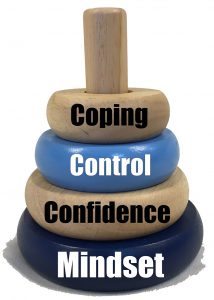 C3 Stands for Coping
C3 Stands for Coping
With a growth Mindset, a sense of Confidence – being capable of improvement, and feeling an inner sense of Control over how we feel and respond, we can learn skills that help us manage the hard times – Coping skills.
It is about dealing with negative emotions and circumstances. There is one immutable law of human existence – Stuff Happens! Coping is about learning how to deal when stuff happens. Only after children gain confidence and control can they become competent at coping with calmness.
One of the single best coping strategies is humor. Laughing at the misfortune of others is why shows like America’s Funniest Videos do such a great job of cracking us up. We must learn to laugh at ourselves at times. We have to learn the art of finding fortune in misfortune – to find the one good thing in a bad situation. To help kids learn coping skills, we first acknowledge the negative emotions or the crappy situation, then deal with the situation. “That stinks, now… what can we do to MAKE THE BEST OF IT?”
To help children and youth develop coping skills, we teach them calming techniques – breathing techniques like taking a series of slow breaths in through their nose and even slower breaths out through their mouth. We teach them progressive muscle relaxation exercises like first tensing and then relaxing their muscles starting at their toes and ending with the muscles in their faces.
We ask them to stop, be mindful, and be a S.T.A.R. – which means to Smile, Take Breaths, And Relax. before reacting to the situation. We know the longer they delay before reacting, the longer of a list of options they can create. The more options they can create, the more likely they are to come up with an effective and appropriate response.
We can help people change their inner voice from a fixed to a growth voice by providing them with optimistic self-talk dialog. It’s the kind of stuff that helped the little blue engine that could, to climb that mountain, “I think I can, I think I can, I think I can.” We teach our kids to say things like, “You can do this. Slow down. Just take one step at a time.”
Teaching problem-solving skills is a powerful coping strategy. First, ask questions until everyone understands the problem. Then, create a long list of options. Next, pick a strategy and putting it into practice. Try it out and see if it works. And evaluate – ask, “Did that work?” “What part didn’t work so well?” “If you could go back and try it again, what strategy do you think you might pick this time?”
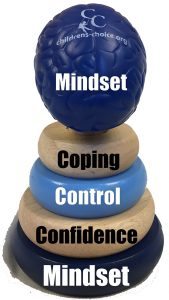 Grit = Mindset (Confidence X Control X Coping).
Grit = Mindset (Confidence X Control X Coping).
Mindset gives us the understanding that we can learn and improve with effort. Confidence gives us the sense of feeling capable. Control teaches us that we are in control over how our brains grow, how much effort we put into the process, and how we choose to behave and react to situations. Coping helps us keep going, bounce back, and solve problems when stuff happens. These skills are building blocks necessary for people to build passion and perseverance for long-term goals = Grit.
For breakfast, today I had a green chile and egg breakfast burrito. Mmmm… spicy!
Author: @mikeashcraft
References:
Duckworth, Angela Lee. (2016). Grit: The Power of Passion and Perseverance. New York, NY: Scribner.
Dweck, Carol, S. (2006). Mindset: The New Psychology of Success. New York, NY: Random House.
